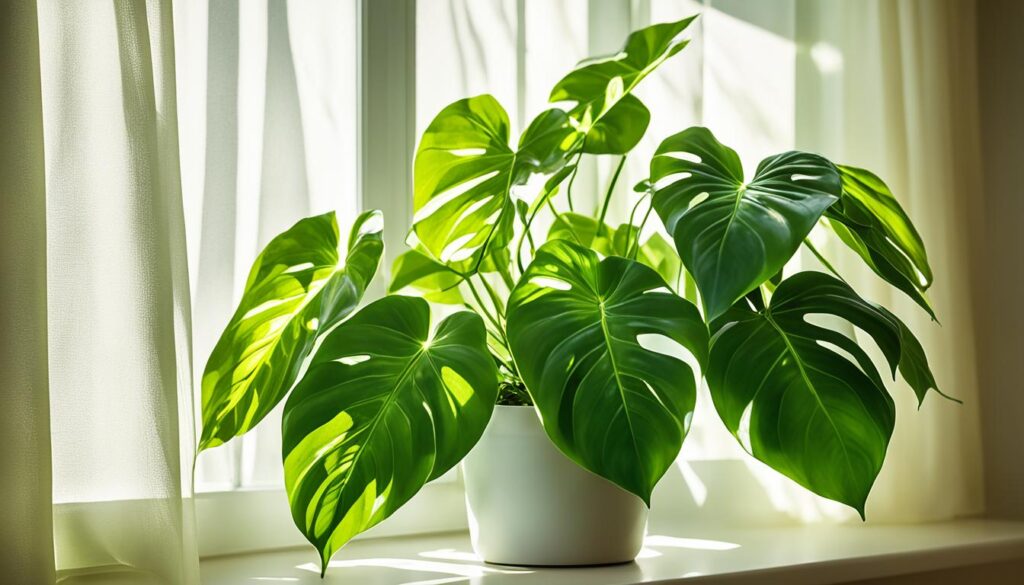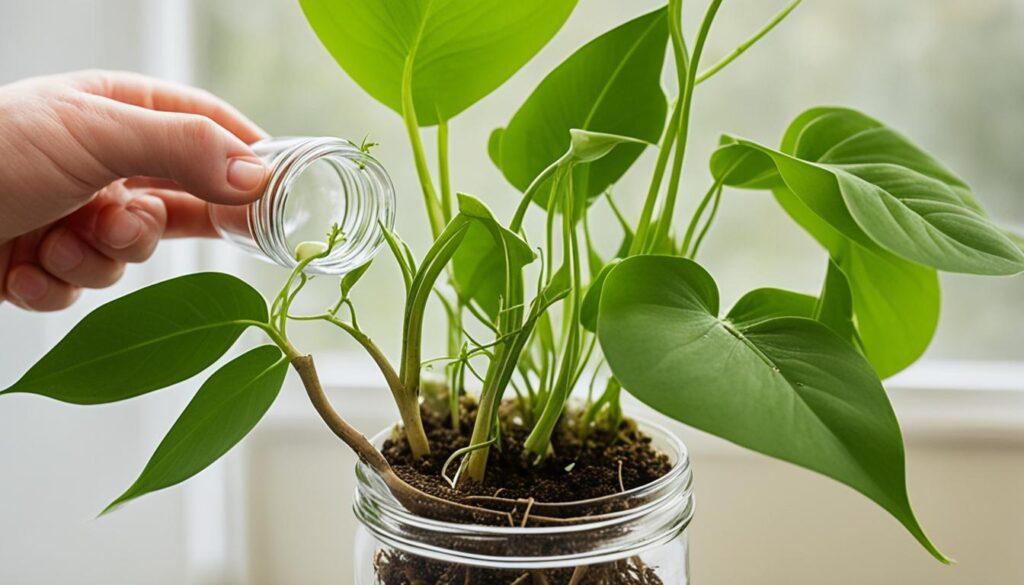Philodendrons are loved for being easy to care for. They have big, shiny green leaves. They make any space look great. These plants do well indoors if they get enough water and light.
There are two kinds of philodendrons. Some grow straight up, and others need something to climb on. But, their care tips are almost the same. Philodendrons are also good at cleaning the air in your living space.
Key Takeaways
- Philodendrons tolerate low light levels but grow faster in bright, indirect sunlight.
- Philodendrons must avoid direct sunlight as it can quickly burn the leaves.
- Overwatering can lead to root suffocation and root rot disease in philodendrons.
- Philodendrons thrive in loose, well-drained soil high in organic matter.
- Fertilize philodendrons regularly during the growing season for optimal growth.
Introduction to Philodendrons
The word “philodendron” comes from the Greek for “love” and “tree.” It’s a type of plant with big, shiny leaves. These leaves make any room look like a tropical paradise.
Philodendron Overview
Philodendrons can be split into two groups: ones that climb and ones that stand tall. The climbing ones are great for baskets or up a support. The others, like the lacy tree philodendron, look stunning alone. In their natural habitats, these plants grow really high.
Types of Philodendrons
There are many kinds of philodendrons. Some favorites include the elegant Lacy Tree Philodendron and the cute Heartleaf Philodendron. The Red-Leaf Philodendron is also loved for its colorful leaves. Each one brings something special to room decoration.
Light Requirements for Philodendrons
Philodendrons prefer medium light and bright indirect sunlight. They can handle low light too, but they’ll grow slower. Keep them out of direct sunlight to prevent leaf burns. For instance, Monstera Deliciosa needs bright, indirect sunlight for its leaves to split. Philodendron micans, on the other hand, will get burnt in direct sun. If you see a lot of yellow leaves, it might be getting too much sun. Plants with leggy growth need more light.

Bright, Indirect Sunlight
Philodendrons really do well in bright, indirect sunlight. Indoor Split Leaf Philodendrons, for example, excel under this light. If you see your plant getting leggy or its leaves losing their shine, check the light it’s getting. Moving your plant closer to a light source might help.
Avoiding Direct Sunlight
Direct sunlight is bad for philodendrons. It can damage their leaves quickly. Make sure they’re not in direct sunlight, especially since they’re used to tropical shade. If you’re moving them outdoors, do it gradually to avoid shock.
Watering Philodendrons
Philodendron watering is key to these plants’ life and health. Water them when the top inch of soil is dry. Be careful, as too much water can make them rot. If you see brown leaves, the plant may need more water.
When to Water
Checking the soil’s dryness is vital for watering philodendrons. If the top inch of soil isn’t moist, it’s time to water. Philodendrons could need watering weekly or every two weeks. How often depends on their pot size, the soil, and the place they’re in.
If the leaves droop, it might be from too much or too little water. Fixing the water amount should help the plant look happier.
Overwatering Risks
Overwatering philodendrons can lead to root rot. To prevent this, use pots with good drainage and rich soil. Let the top inch of soil dry between waterings. This will keep your philodendron healthy.
Soil and Potting Mix
Philodendrons love soil that is loose, drains well, and has lots of organic matter. A mix of 100% sphagnum peat moss is good for them. Mixes that include peat like peat-vermiculite or peat-perlite work too. It’s great to use a 50/50 mix of Espoma Organic Potting mix and Espoma Organic Cactus mix. This mix helps with drainage because it has bigger pieces of material.
Well-Draining Soil
Philodendrons do well when they’re a bit tight in their pots. This helps the soil dry out quickly between waterings. They like their soil to be damp but not soaked to avoid root rot. Choose porous pots like unglazed clay or ceramic. These pots dry out quicker than plastic or glazed ones, which is good for philodendrons.
Organic Matter Content
To thrive, philodendrons need nutrient-rich soil with a pH of 5.0 to 6.0. If the soil isn’t right for them, you’ll see yellow, falling, or dry leaves. A soil rich in organic matter helps these plants grow fast and healthy indoors.

Fertilizing Philodendrons
During the growing season, March to November, it’s important to fertilize philodendrons often. You can use two main types of food for them. The first is a granular product like Osmocote Plus Indoor Plant Food, that releases nutrients slowly. The second type is Jack’s Classic Houseplant Special, which you mix with water before using.
Choosing a time-release fertilizer is the simpler choice. Just scatter the right amount over the soil. Then, each time you water, your plant gets nutrients. For water-soluble fertilizers, mix them in with your water each time you water your plant.
Feeding philodendrons correctly is crucial for their health. By giving them the right food on schedule, you’ll see bright, healthy leaves. The best plant food helps your philodendrons grow to their best. This way, you help your plants look and feel their best.
Temperature and Humidity
Philodendrons love warmth and are happy in temperatures between 65 and 78 degrees Fahrenheit. At night, they do well with it dropping a bit to about 60 degrees. If outdoors, make sure it’s not colder than 55 degrees. They also like it humid for their leaves to stay shiny and if you keep the air moist, they’ll feel right at home.
But, if the air is dry, you might see the tips of their leaves turn brown. This tells you the plant might need more humidity. To fix this, misting the plant regularly can do wonders.
Ideal Temperature Range
The perfect temperature range for philodendrons is between 65 and 78 degrees Fahrenheit during the day. At night, a cooler 60 degrees is just right for them.
If they’re outside, it shouldn’t get lower than 55 degrees. This keeps the plant healthy and growing its best.
Humidity Preferences
Philodendrons thrive in high humidity. But they can get by with lower humidity too, if you mist them often. If their leaves start turning brown, it’s a sign they need more moisture in the air.
To meet their humidity needs, try placing plants together or using a humidifier. The water tray method can also boost the air’s moisture level.

Toxicity Concerns
Philodendrons are mildly toxic to household pets. They can cause mouth or throat irritation, drooling, and vomiting if eaten. If your pet shows these signs, wash its mouth with water right away. Then, get them to the vet as soon as possible. Knowing about poisonous plants can keep your pets safe without losing your plant.
Repotting and Pruning
Most of the time, philodendrons won’t need much trimming. But they can look and grow better with a little cut now and then. Use sharp shears to trim away any dead leaves or to control its size. You might also be able to start new plants from these cuttings by placing them in water or soil.
Signs for Repotting
Philodendrons enjoy being a bit cramped in their pots. However, they may need a bigger home as they grow. You should notice if the soil is drying too fast or looks too packed. Other signs could be roots showing at the bottom or slowing growth.
Pruning Techniques
When moving your philodendron to a new pot, find one that’s slightly bigger. Carefully take the plant out and check for circling roots. Put it in new soil, then water it well. It’s best to slowly introduce it to a spot with lots of bright, but not direct, sunlight.

Pests and Problems
Philodendrons usually stay clear of bugs. Yet, they could get philodendron pests like aphids and mealybugs. Try using cotton balls soaked in alcohol to wipe off mealybugs. Also, giving your plant a shower and using insecticidal soap can help.
Common Pests
Philodendrons are not too hard to take care of. But they might face issues like aphids and mealybugs. For these bugs, a close eye and treatments with soap or alcohol can work well.
Leaf Discoloration Issues
Overwatering is a big issue for philodendrons. It causes yellow or wilting leaves and can lead to problems like leaf spot. To fix this, check your watering, make sure water can drain well, and cut off sick parts.
If overwatering has led to roots rotting, your plant might need a new home. Repot it in soil that lets water flow through easily.
Propagating Philodendrons
To make more Philodendrons, you can use stem cuttings or water. Just snip a stem right beneath a node. Nodes are where leaves used to be. Then, put it in water with the node under, keeping it away from direct sunlight. When roots show up, move it to new soil.
Stem Cutting Method
For water, it’s easy. Drop a philodendron cutting into a water container to grow roots. Soon you’ll have a new baby plant. Philodendrons love growing this way.
Water Propagation
Philodendrons are great for making more because you can use many methods. This makes them loved by plant fans. Use stems or water for new plants to sprout, and watch them grow strong.

how much light does a philodendron need
Philodendrons need six to eight hours of bright, indirect sunlight per day for best results. Some philodendron varieties do well in less light. Yet, they will grow better with more light. It’s crucial to keep them out of direct sunlight. This can harm the leaves. Place your philodendron near a window for bright, indirect light all day.
Conclusion
Philodendrons are classic, low-maintenance houseplants perfect for indoors. Keep them healthy by placing them in bright, indirect sunlight. Water them when the surface of the soil is dry.
They grow best in well-draining soil. Remember to feed them during the growing season. Keep the room temperature between 65-78°F with some extra humidity. Look out for pests and signs of disease. Prune or repot if needed. Under the right conditions, philodendrons can stay beautiful for a long time.
To make your philodendron look its best, get the light, water, and soil right. The right care will make it a lovely part of your home. Follow the philodendron care summary and philodendron growing tips.
These plants will flourish with your care. They will be a joy and a highlight in your space.


